Accepted Scientific Name: Ptychosperma elegans (R.Br.) Blume
Rumphia 2: 118 (1843) Blume
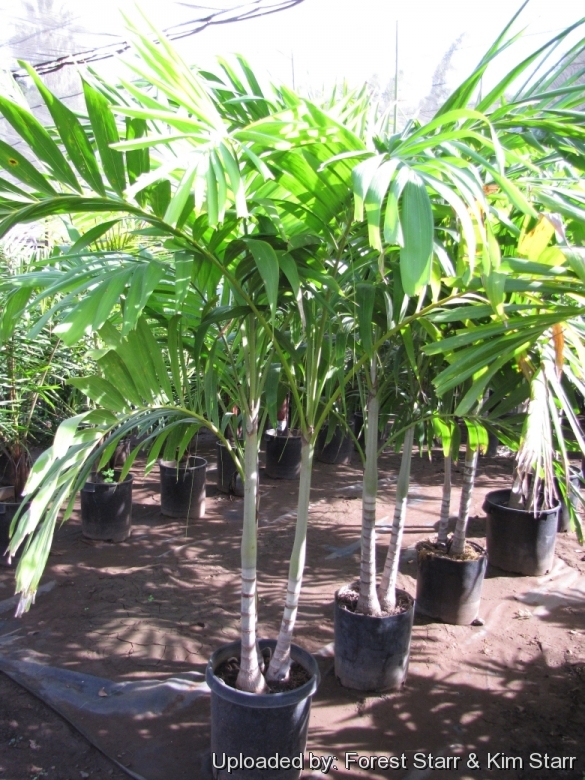
Saguaster elegans (Ptychosperma elegans) Photo by: Forest Starr & Kim Starr
Habit at Resort Management Group Nursery Kihei, Maui, Hawaii (USA). February 09, 2011.
Origin and Habitat: Eastern Queensland, Northern Australia.
Altitude: Elevation range from near sea level to 900 metres.
Habitat: Grows as an understory plant in coastal and upland moist tropical rainforest.
Synonyms:
See all synonyms of Ptychosperma elegans
back
Accepted name in llifle Database:Ptychosperma elegans (R.Br.) BlumeRumphia 2: 118 (1843)Synonymy: 15
back
Common Names include:
ENGLISH: Solitaire palm, Alexander palm, Cabbage palm, Bangalow, Elegant Palm, Elegant Stem palm
CHINESE (中文): You ya zhou zi zong
FRENCH (Français): Palmier solitaire
GERMAN (Deutsch): Solitairepalme, Solitairepalme
PORTUGUESE (Português): Palmeira-solitaria
SPANISH (Español): Palmera solitaria
Description: Ptychosperma elegansSN|28652]]SN|28637]] is one of the few Ptychosperma species with solitary trunk, (most sucker). It flowers and fruits when still small.
Trunk: Slender 10-12 cm in diameter and up to 15 metres of height (but often less than 10 m tall in cultivation), bulging at the base, green in the younger part and greyish or almost white in the older one with dark leaf base scars that encircle the trunk and lighten in colour with age.
Crown: It carries a small head of semi-erect whorl of fronds.
Crownshaft: The foliar base wraps entirely the top of the trunk for a length of 40-50 cm forming an olive-green crownshaft. The crownshaft has a bulging base and smooth waxy surface.
Leaves: Up to to 3(-3,3) metres long, pinnately compound, reduplicate, arching leaves with 30-60 wide premorse leaflets (indented at the ends in the typical Ptychosperma fashion), narrowly oblong, widest toward the middle, opposite from one another on the rachis, in a single plane, displaying a "V" shaped appearance, long even 1 metre in the median part, glossy intense green on the topside and grey-green on the underside. Petiole 30 cm long.
Inflorescence: 60-100 cm long pendulous under the leaves just below the crownshaft, green-yellow heavily branched to two or three orders. Flowers three-petaled, unisexual borne on the same inflorescence, cream-green, in triad (a feminine flower between two masculine ones). Male flowers1.5-2 mm long, whitish to light green with 12-22 per flower (the female parts are developed but the ovules are absent in the male flowers). Female flowers whithis-green.
Fruit: Globose to ellipsoid, 9-15 mm of length, 8-10 mm diameter, bright red when mature and have remnants of the stigma at the apex.
Seed: 10-11 mm long, 5-angled. Endosperm deeply ruminate.
Seedlings: First pair of leaves compound with two sessile, longitudinally veined leaflets up to 7 cm long.
Remarks: Ptychosperma elegansSN|28637]]SN|28637]] may be confused with Ptychosperma macarthuriiSN|28637]]SN|28652]], but it is a smaller statured, clustering palm with drooping rather than ascending leaflets.
Bibliography: Major references and further lectures
1) Wikipedia contributors. "Ptychosperma elegans." Wikipedia, The Free Encyclopedia. Wikipedia, The Free Encyclopedia, 7 Jun. 2014. Web. 8 Sep. 2014.
2) Forest & Kim Starr Ptychosperma elegans (Solitaire palm). Plants of Hawaii. <http://www.starrenvironmental.com>. Downloaded on 21 August 2014.
3) Palmpedia contributors. "Ptychosperma elegans ." Palmpedia, PALM ENCYCLOPEDIA, <http://www.palmpedia.net> Downloaded on 8 Sep. 2014
4) "Ptychosperma elegans ." PACSOA Palms and Cycads wiki , <http://www.pacsoa.org.au> Accessed on 28 Aug. 2014
5) Borror, D. J. “Dictionary of root words and combining forms” (2nd ed.). Mountain View, CA: Mayfield Publishing Company.1988
6) Gledhill, D. “The names of plants” (2nd ed.). Cambridge: Cambridge University Press1989.
7) Meerow, A. W. “Betrock’s guide to landscape palms” (9th ed.). Hollywood, FL: Betrock Information Systems. 2004
8) Ogren, T. L. “Allergy-free gardening: The revolutionary guide to healthy landscaping” . Berkeley, CA: Ten Speed Press.2000
9) Riffle, R. L. and P. Craft. “An encyclopedia of cultivated palms” . Portland, OR: Timber Press, Inc.2003
10) Heather V. Quintana, Michael G. Andreu, Melissa H. Friedman, and Mary McKenzie “Ptychosperma elegans, Solitaire Palm” FOR 251, School of Forest Resources and Conservation, Florida Cooperative Extension Service, Institute of Food and Agricultural Sciences, University of Florida. <http://edis.ifas.ufl.edu> Reviewed April 2013.
11) White, Alan. “Palms and Cycads.” 1988.
12) "Ptychosperma elegans ." National Tropical Botanical Garden <http://ntbg.org/plants/plant_details.php?plantid=9677> Downloaded on 8 Sep. 2014
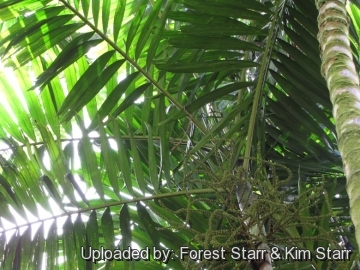 Flowers and crown at Keanae Arboretum, Maui, Hawaii (USA). February 16, 2012. (Ptychosperma elegans) Photo by: Forest Starr & Kim Starr
Flowers and crown at Keanae Arboretum, Maui, Hawaii (USA). February 16, 2012. (Ptychosperma elegans) Photo by: Forest Starr & Kim Starr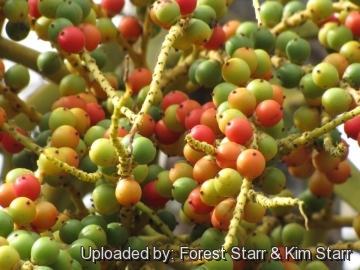 Green and red fruit at Kihei Garden and Landscape Wailuku, Maui, Hawaii (USA). January 21, 2010. (Ptychosperma elegans) Photo by: Forest Starr & Kim Starr
Green and red fruit at Kihei Garden and Landscape Wailuku, Maui, Hawaii (USA). January 21, 2010. (Ptychosperma elegans) Photo by: Forest Starr & Kim Starr Fruiting habit at Kihei Garden and Landscape Wailuku, Maui, Hawaii (USA). January 21, 2010. (Ptychosperma elegans) Photo by: Forest Starr & Kim Starr
Fruiting habit at Kihei Garden and Landscape Wailuku, Maui, Hawaii (USA). January 21, 2010. (Ptychosperma elegans) Photo by: Forest Starr & Kim Starr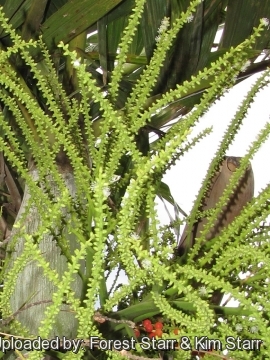 Flowers at Kihei Garden and Landscape Wailuku, Maui, Hawaii (USA). January 21, 2010. (Ptychosperma elegans) Photo by: Forest Starr & Kim Starr
Flowers at Kihei Garden and Landscape Wailuku, Maui, Hawaii (USA). January 21, 2010. (Ptychosperma elegans) Photo by: Forest Starr & Kim Starr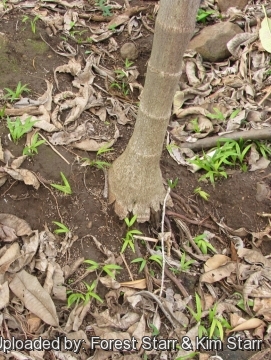 Seedlings at Kihei Garden and Landscape Wailuku, Maui, Hawaii (USA). January 21, 2010. (Ptychosperma elegans) Photo by: Forest Starr & Kim Starr
Seedlings at Kihei Garden and Landscape Wailuku, Maui, Hawaii (USA). January 21, 2010. (Ptychosperma elegans) Photo by: Forest Starr & Kim StarrSend a photo of this plant.The gallery now contains thousands of pictures, however it is possible to do even more. We are, of course, seeking photos of species not yet shown in the gallery but not only that, we are also looking for better pictures than those already present.
Read More... Cultivation and Propagation: This palm is an excellent pretty fast growing garden plant adapt to different tropical climates. It is also one of the most elegant indoor palms.
Soil requirements: It prefers well-drained fertile, organic, nutrient-laden soils except those that are constantly soggy. However it is widely adaptable including those that are neutral, acidic, clayey and slightly alkaline.
Watering: It prefers regular waterings and should be watered before the soil completely dries. Don't let sit in water. Indoor, potted Ptychosperma should not be over-watered. They may contract the fungus Phytophthora, if over-watered.
Light: Outside they grow best in half sun and tolerating direct sun only after about five years old. Young specimens need protection from direct sunlight and grow best in shady to partly shady locations. If home-grown, they look their best in bright diffuse light.
Fertilization: Need a perfect low-release fertilizer (e.g., 18-18-18) diet including all micro nutrients and trace elements. It is subject to magnesium and potassium deficiency
Hardiness: They grow well in tropical and subtropical climates, however it is one of the only 'hardy' Ptychosperma species that can handle temps down to -6° C without any problems; For safe cultivation normal temperatures should not go below 5°. (USDA Zones 9b – 11)
Wind tolerance: Keep out of high, drying cold winds.
Maintenance: Remove dried fronds.
Garden uses: It is grown in open air, in the sub tropical and warm-temperate zones, for the decoration of parks and gardens, in a partly shaded location when young, and regularly watered. Because of its reduced size and its elegant look, the Ptychosperma elegansSN|28637]]SN|28637]] proves to be particularly suitable for its utilization in patios and in great open inner courts.
It has a fairly good employment, in pot, for indoor decoration.
Disease & Pests: It is quite resistant to pests but may require regular fertilization to prevent yellowing caused by potassium deficiencies; protect against spider mites, scale insects. Protect from frost.
Propagation: By seeds that germinate well in 2-3 months and are readily available.














